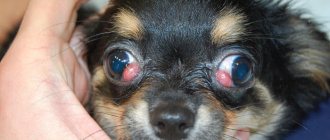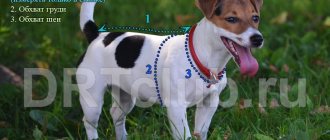What kind of organ are the paraanal glands?
The occurrence of complications is often associated with a lack of appropriate knowledge. After all, detecting a diseased organ without knowing about its existence is an almost impossible task. To fill in the gaps, it is enough to clarify only 2 points: find out the location and features of the functioning of the paraanal glands.
Location
The mysterious organ is hidden right behind the anus - not far from its transition to the rectum. It consists of two symmetrical “bags” filled with odorous secretion. Due to their location, these seals cannot be seen, but can be felt.
Operation
The secretion secreted by the paraanal glands in dogs has an individual smell. It is this that animals “read” when getting to know each other, when they sniff the back of the body of a new acquaintance.
In the absence of pathologies, the secretion produced periodically comes out. This occurs when defecation, leaving territorial marks or strong emotional arousal.
When natural outflow is disrupted, fluid accumulates inside. Blockage of the excretory ducts is accompanied by inflammation of the organ. This can lead to a number of complications, including tissue rupture. To save the animal, cleansing is done manually.
Why are the anal glands cleaned?
The perianal glands are a specific paired organ located in the area of the exit from the rectum. The ducts of the paraanal glands exit immediately into the anal area. These glands produce a specific, brightly smelling secretion that animals need to recognize each other in a pack, attract sexual partners, or mark territorial boundaries.
Physiologically normally functioning glands are independently emptied during the act of defecation. In some cases, the secretion may “fly out” during active physical activity in the animal or when the dog experiences severe stress.
Sometimes, the anal glands become clogged and cannot empty themselves. Narrowing of the ducts or the appearance of clots in the specific fluid produced by the gland can cause inflammation.
Various factors can provoke changes in the composition of the secretion of the perianal glands. The reasons may include poor diet, lack of sexual activity, penetration of pathogenic bacterial microorganisms into the gland, and improper care of pets. Inflammation in the area of the paraanal glands is diagnosed in various dogs, but dogs of dwarf and toy breeds are at risk.
Signs of the development of inflammation in the paraanal glands in a dog are:
- severe itching in the anal area - the dog begins to actively bite itself under the tail, may try to ride on its butt on hard and rough surfaces (this behavior is believed to be characteristic of helminth infections, in fact, the cause is inflammation in the area of the anal glands);
- severe pain syndrome - the dog, when the owner tries to touch the tail or croup, shows anxiety and sometimes aggression;
- the appearance of a repulsive odor from the animal, especially when it turns its tail towards the owner.
If the above symptoms occur, it is necessary to clean the glands using gentle pressure on the gland.
In a veterinary clinic, the procedure is much easier and safer. The specialist will not only clean the glands, but also carry out sanitation with special antiseptic solutions. After cleaning, it is recommended to insert a suppository with an anti-inflammatory effect into the anus.
If the perianal glands are not cleaned on time, the pathological process may be complicated by the addition of pathogenic bacterial microflora, characterized by the accumulation of pus and the development of an abscess.
When an abscess ruptures, a fistula may occur. It cannot be done without surgical intervention. If your pet has a complication of the inflammatory process in the anal glands, the glands are cleaned, drainage is installed and they are washed with antiseptic solutions. Special ointments and suppositories with an anti-inflammatory effect are prescribed. It is necessary to prescribe a course of antimicrobial agents.
Possible causes of inflammation
For pets, the exocrine function has long ceased to be necessary. They do not fight for the female and rarely mark territory. The once important organ gradually becomes rudimentary and is less and less cleansed naturally.
Other causes of inflammation of the paraanal glands in dogs include:
- low activity and excess weight, which impair intestinal motility;
- frequent digestive problems including diarrhea and constipation;
- weak immunity;
- improper feeding of bones, excess protein, insufficient or excessive amount of fiber in the diet;
- frequent mating and pregnancy;
- infection with bacteria, viruses or helminths;
- anal area injuries;
- infrequent walks, forcing you to restrain the urge to defecate;
- neglect of hygiene;
- congenital disorders in the development and position of the organ.
Establishing the cause of inflammation is an important part of further therapy. Eliminating it increases the chances of preventing relapses.
What are the anal glands for in dogs?
By the way, what kind of organs are these and what are the paraanal glands for in dogs? Let's answer the first question first. The paraanal glands, also called “peri-anal sinuses,” are two small organs located on the sides of the animal’s anus.
The sinuses secrete a brownish secretion that has an extremely unpleasant, “stunning” odor. In addition, it is quite aggressive from a chemical point of view. These secretions are necessary to lubricate feces at the final stage of their movement into the external environment.
They prevent the development of constipation and irritation of the anus. In addition, the “fragrant” secretion is necessary for the identification of an animal by its relatives by smell; dogs use it to mark out their territory.
The odorous secretion of these glands is essential for normal life. The problem is that secretion in the sinuses is poorly regulated by the body. Normally, the secretion is enough to moisten your pet's feces up to three times a day (this is the normal frequency of bowel movements for an adult dog).
Symptoms by stage of development
Depending on the symptoms that appear during inflammation of the paraanal glands in dogs, the pathological process is divided into 4 stages. As the serial number increases, the likelihood of complications aggravating further treatment increases.
First stage
The initial stage is accompanied by severe itching and a gradual reduction in the amount of secretion produced. It remains transparent or acquires a yellowish tint. To eliminate itching, the dog constantly licks himself or cuts circles on his butt.
This symptomatology is similar to helminthiasis. Do not rush to give an anthelmintic before diagnosis. Not only will this not help, but it will also weaken your immune system.
Second stage
The development of inflammation is accompanied by thickening of the secretory fluid and a reduction in its volume. Due to frequent scratching, the hair in the affected area begins to fall out. The inner surface of the thighs is covered with tiny bubbles with transparent or cloudy contents. The hind limbs are constrained by spasms that impair coordination.
Third stage
Secretory fluid is practically not secreted. It resembles a thick cream and becomes darker. Due to the growth of bacteria attracted by stagnation, inflammation spreads to adjacent tissues. The spasms get worse. Instead of single muscle contractions, cramps appear.
Fourth stage
The escaping liquid resembles grainy cottage cheese and turns black. If the ducts are completely blocked, paralysis of the hind limbs and the development of an abscess are possible. The patient experiences severe pain not only during bowel movements, but also at rest. A sharp increase in temperature to 40 °C indicates blood poisoning, which can be fatal. The animal requires urgent hospitalization.
Paraanal glands: disease prevention.
To exclude blockage and inflammation of the paraanal glands, it is necessary to periodically check the condition and carry out regular, every 3-9 months, depending on the condition and predisposition to this disease, sanitation of the paraanal glands - forced mechanical cleansing of the glands and washing of the anal area with warm soapy water for the purpose of mechanical cleaning of the glands . It is better to go to a pet salon or veterinarian for a cleaning procedure and not to carry out sanitation yourself, since there are many blood vessels and nerve endings in this area and you can do more harm than help. In addition, the amount of secretion, the rate of its accumulation, the frequency of emptying of the glands are the individual characteristics of the dog’s body; the pet salon master will perform the procedure or recommend contacting a veterinarian and will tell you when to come next time.
At-risk groups
The risk group includes pregnant and lactating females, as well as some representatives of small breeds: dachshunds, pugs, Pekingese, Spitz, Shih Tzu. If you follow the recommended caloric intake of food and regularly walk your pet, not forgetting about outdoor games, make sure that he is not naturally prone to excess weight. In this case, any deviation from the listed actions is fraught with the sudden development of pathology.
Diagnosis of the disease
An examination in a veterinary clinic is carried out to exclude similar pathologies, identify the cause and stage of the inflammatory process. You shouldn’t delay making an appointment until your condition worsens. Lethargy, lack of appetite and unbearable itching are quite serious symptoms that require a mandatory examination of the four-legged patient.
The list of mandatory diagnostic tests includes a blood test, skin scraping and assessment of secretions. If there is pus, blood or a foul odor, a bacterial culture test is also taken, which determines the type of bacteria and their sensitivity to antibiotics. Other diagnostic methods are prescribed on an individual basis.
Treatment methods
In most cases, the blockage is removed by mechanical cleaning. Rinse and surgery are prescribed when the process is advanced, and drugs are used to eliminate inflammation and kill bacteria.
Drug therapy
For inflammation of the paraanal glands in a dog, rectal suppositories (Methyluracil, Proctosedyl, ichthyol suppositories) are used for treatment. They not only have an anti-inflammatory effect, but also increase tissue regeneration. A contraindication for use is a violation of the integrity of the organ.
To relieve pain, a novocaine blockade is prescribed, and the bacterial infection is eliminated with a course of antibiotic therapy. Due to possible side effects, all dosages and duration of treatment are determined by the doctor.
Washing
Patients with stages 3 and 4 of the inflammatory process undergo washing of the “bags”, clearing them of accumulated pus. During the procedure, local anesthesia is used. After opening the abscess, the surgeon removes its contents and rinses the ducts with an antibacterial solution. The resulting wound heals quickly if you avoid licking it with a veterinary cone.
Mechanical cleaning
In the first stages, the blockage is removed by mechanical cleaning. It is carried out in 2 ways:
- Outer
. The “bags” are wrapped around the outside with your fingers and squeezed towards each other. After the fluid has drained, the anus is treated with Vaseline.
- Interior
. With a finger inserted into the anus, you need to feel the inflamed organ and try to squeeze out the secretion from it through gentle massage movements.
The second method is carried out strictly in a veterinary clinic, since in the absence of skills it can lead to injury to the anus. The external method is easier and less dangerous, so it can be used at home.
Surgical intervention - removal
In case of advanced inflammatory process, congenital pathologies or frequent relapses, anal sacculectomy is recommended, that is, removal of the “sacs”. The operation does not affect the quality of bowel movements, since it does not affect the anus and rectum. Within a day, the pet returns to normal activity.
During rehabilitation, it is important to increase the frequency of walking. Frequently holding back the urge leads to constipation, which can lead to sutures coming apart. Wound healing is also facilitated by following a special diet.
Paraanal glands: manifestation of diseases.
Signs of the disease are itching, restlessness of the animal, pain in the tail area and even hair loss in the back of the body and paws. As a rule, this indicates blockage of the paraanal glands due to disruption of the natural outflow and overflow of the paraanal sinuses with secretions. Initially, the animal does not show concern, but as the secretion thickens, its color changes to dark brown and flakes form, and the pet begins to painfully perceive touches on the tail and thighs of the hind limbs. The secretion is absorbed into the blood, which leads to severe itching, so the dog continuously itches and licks the skin above the base of the tail.
Even if the paraanal glands are released from secretions in a timely manner, as a result of microtraumas of the rectum at the anus, an inflammatory process of the paraanal glands and surrounding tissues, suppuration or an abscess can occur, which, as it matures, breaks through and forms a fistula of the paraanal gland. It is necessary to carefully monitor the animal after opening the abscess to prevent the wound from healing with connective tissue and causing a recurrent fistula. In this case, the pet experiences pain when defecating, when walking, and even at rest; the body temperature rises to 40 degrees. In this case, death cannot be ruled out.
Dietary regime
The diet is based on easily digestible foods enriched with fiber. Regular consumption of dietary fiber prevents blockage of the ducts by stimulating peristalsis. Additionally, you can take vitamin and mineral complexes prescribed by your veterinarian.
To prevent constipation and diarrhea, it is recommended to use only fresh food, avoiding reheating food. To avoid overfeeding and excessive stress on the intestines, increase the frequency of feedings by reducing the size of portions. Eliminate all prohibited foods from your diet: canned food, sweets, pickles and other dishes from the human table.
When dry feeding, it is recommended to choose food from a veterinary line. Pay attention to the series recommended for digestive problems. The exact brand and serving size should be checked with your doctor.
Do-it-yourself cleaning at home
Self-cleaning is carried out for preventive purposes when the diagnosis is already known. For the safety of your pet, it is important to rule out other diseases and make sure there are no complications.
Frequency
On average, it is enough to clean the ducts every six months. Depending on the individual characteristics of the animal, the interval can be increased or decreased. If blockage occurs monthly or even more often, then the problem is eliminated surgically.
How to perform the procedure
It is better to perform the procedure in the bathroom while washing. If you live in a private house, you can go outside during the warm season. Prepare old, unwanted clothing and latex gloves in advance to protect yourself from odorous secretions. Also make sure you have an assistant ready to restrain the dog.
Armed with Vaseline, napkins and a basin, proceed with the following actions with your partner:
- Place your pet in the bathtub and gently lift his tail towards his back. Place your pelvis directly under your anus. It is enough to simply place a small dog in a basin.
- Gently feel the anal area, looking for two lumps.
- Lubricate the anus with Vaseline and gently squeeze the seals, placing a napkin under the leaking secretion.
- After the accumulated fluid has come out, wash your dog and re-lubricate his anus with Vaseline. Use rectal suppositories for the next 4 days.
If there is no secretion, do not increase the pressing force. This may harm the animal. Complex cases are treated only under the supervision of a veterinarian.
Treatment of the inflammatory process of the paraanal glands
A qualified veterinarian should treat inflamed anal sacs in a cat. The choice of tactics and method of treatment for inflammation of the paraanal glands in cats depends on several factors: the individual characteristics of the animal’s body, the state of the pet’s immunity, the nature of the disease and the neglect of the pathological process with the presence of complications.
In practice, therapy for the disease is implemented by mechanically cleansing the cavity of the paraanal glands from infected secretions, followed by prescribing a course of antibiotic therapy, novocaine blockades and rectal anti-inflammatory suppositories. In most cases, veterinarians prescribe injectable antibiotics from the gentamicin and penicillin groups to their patients. To eliminate discomfort and itching in the anal area, a specialist may decide on the need to take general antihistamines.
To increase the reactivity of a cat’s body and improve the condition of its immune system, the animal needs to introduce food rich in vitamins and nutrients into its daily diet or give synthetic multivitamins for cats, which can be purchased at any veterinary pharmacy.
Chronic inflammation with frequent relapses of the disease requires surgical intervention - resection of the paraanal glands followed by plastic surgery of the perianal zone. Treatment of anal gland abscess in a cat is carried out by surgically opening the anal sacs and draining their cavity.
Possible complications
Prolonged blockage of the ducts attracts pathogenic microorganisms that cause an inflammatory process. This leads to the development of suppuration and damage to nerve endings. The lethal outcome increases with the development of sepsis.
Abscess
An abscess of the paraanal glands in a dog is accompanied by an increase in body temperature, redness and swelling of the anal area. The formation filled with pus can break through at any time and infect neighboring tissues, forming a fistula.
Fistula
Fistula is a cavity formed after opening an abscess. A small hole appears near the anus. It oozes white, yellow or greenish pus with a pungent odor. It may contain blood impurities.
Intestinal problems
Damage to the intestinal mucosa, caused by the appearance of an abscess or fistula, complicates the act of defecation. Constipation occurs, which can lead to intestinal obstruction. Accumulating feces can lead to intestinal rupture and intoxication of the body.
Inflammation of the perianal glands. Which animals are most at risk?
- animals with a physiologically narrow canal of the perianal glands;
- animals in which a tight secretion of glands is formed;
- no age or gender predispositions have been identified, but it has been established that inflammation of the perianal glands most often occurs in small breed dogs (poodles, chihuahuas, Yorkshire terriers, dachshunds, cockers, beagles) prone to obesity;
- The risk of inflammation of the perianal glands increases for animals that have a diet low in protein and fiber; cats rarely get sick.
If there are no recommendations from a veterinarian, you should not empty your animals’ perianal glands often and for no reason!!!











